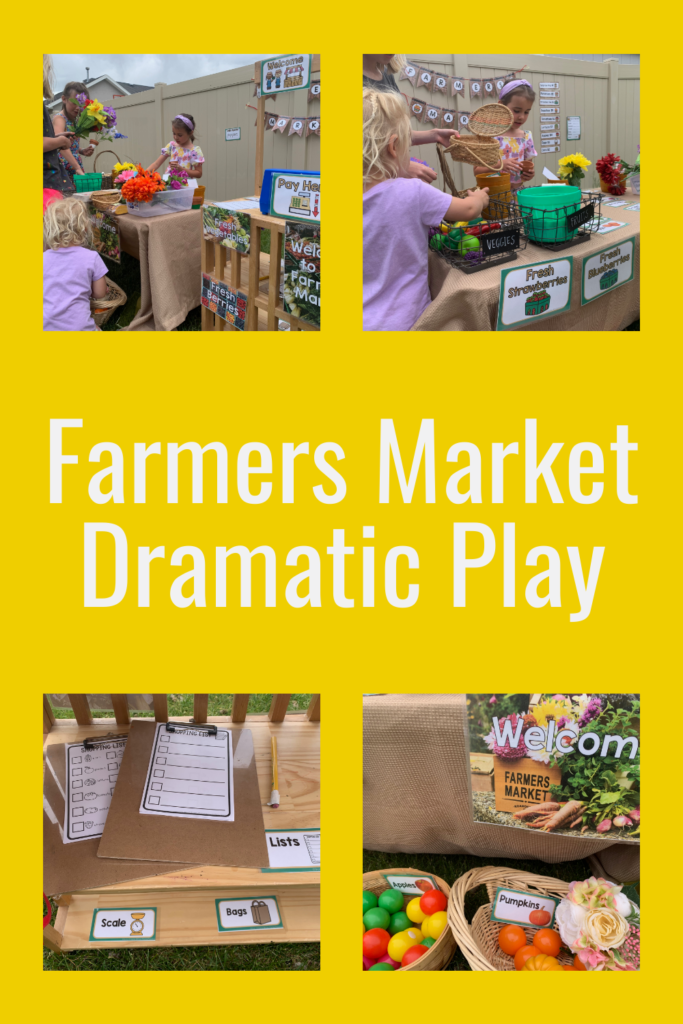Are you looking to spice up your preschool, prek or kindergarten classroom with some new and exciting activities? Setting up a farmers market dramatic play corner is an engaging way to get children involved in imaginative play while teaching them about where their food comes from. Whether you have a full room to work with or just a small corner, there are plenty of ways to create an inviting and educational farmers market dramatic play experience for your students. In this blog post, we will discuss the basics of setting up a farmers market dramatic play corner and provide helpful tips and ideas to ensure success.
Disclaimer: Some links in this post are affiliate links. I may receive a small commission at no extra cost to you if you use the links – plus I would so greatly appreciate your support. Thank you.
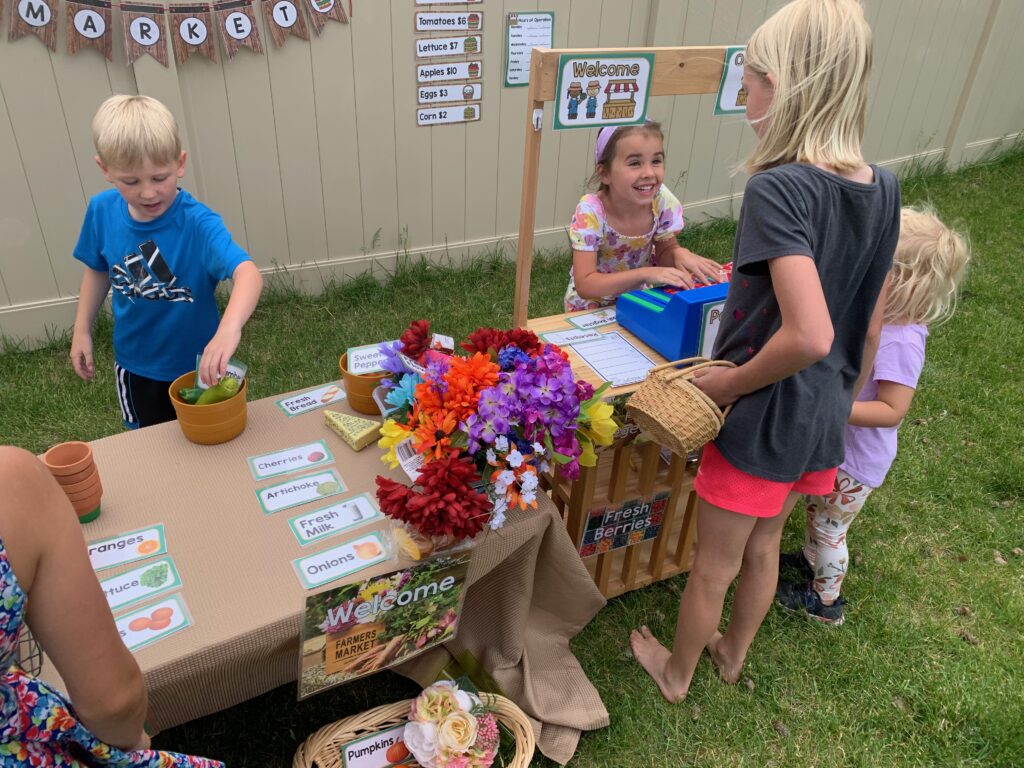
Benefits of a Farmers Market Dramatic Play Center
The preschool farmers market dramatic play center is a valuable addition to any classroom. Here are some benefits of setting up this kind of play area for your students:
- Development of social skills: The farmers market play center provides an excellent opportunity for young children to practice their social skills. As they engage in pretend play, they learn to take turns, communicate effectively with others, and negotiate and solve problems in a safe and fun environment.
- Stimulates imagination: The farmers market play center encourages imaginative play as children pretend to be vendors, customers, and market organizers. This type of play encourages creativity and helps to develop critical thinking skills as children must figure out how to solve problems related to buying and selling items.
- Encourages language development: The farmers market play center provides a natural setting for children to develop their language skills. As they engage in conversations with peers and adults, they learn to express themselves, use descriptive language, and learn new vocabulary related to food and commerce.
- Learning about food and nutrition: The farmers market play center provides an opportunity for children to learn about healthy food choices and nutrition. Children can learn about the various types of fruits, vegetables, and other food items and how they contribute to good health.
Overall, setting up a farmers market dramatic play center in your classroom is a fun and effective way to engage children in hands-on learning. With proper guidance, young children can develop important social, cognitive, and language skills while also learning about healthy food choices and the world of commerce.
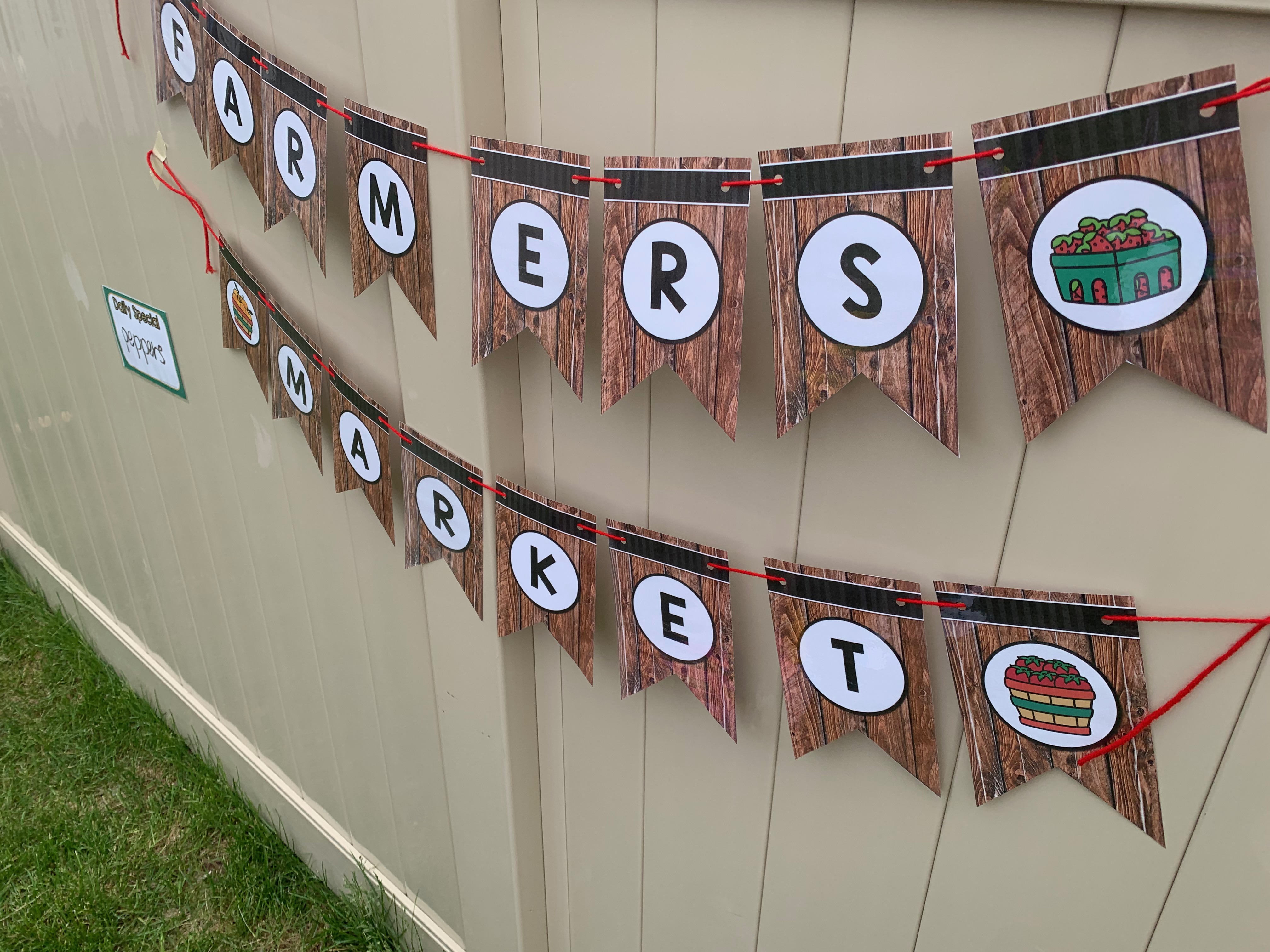
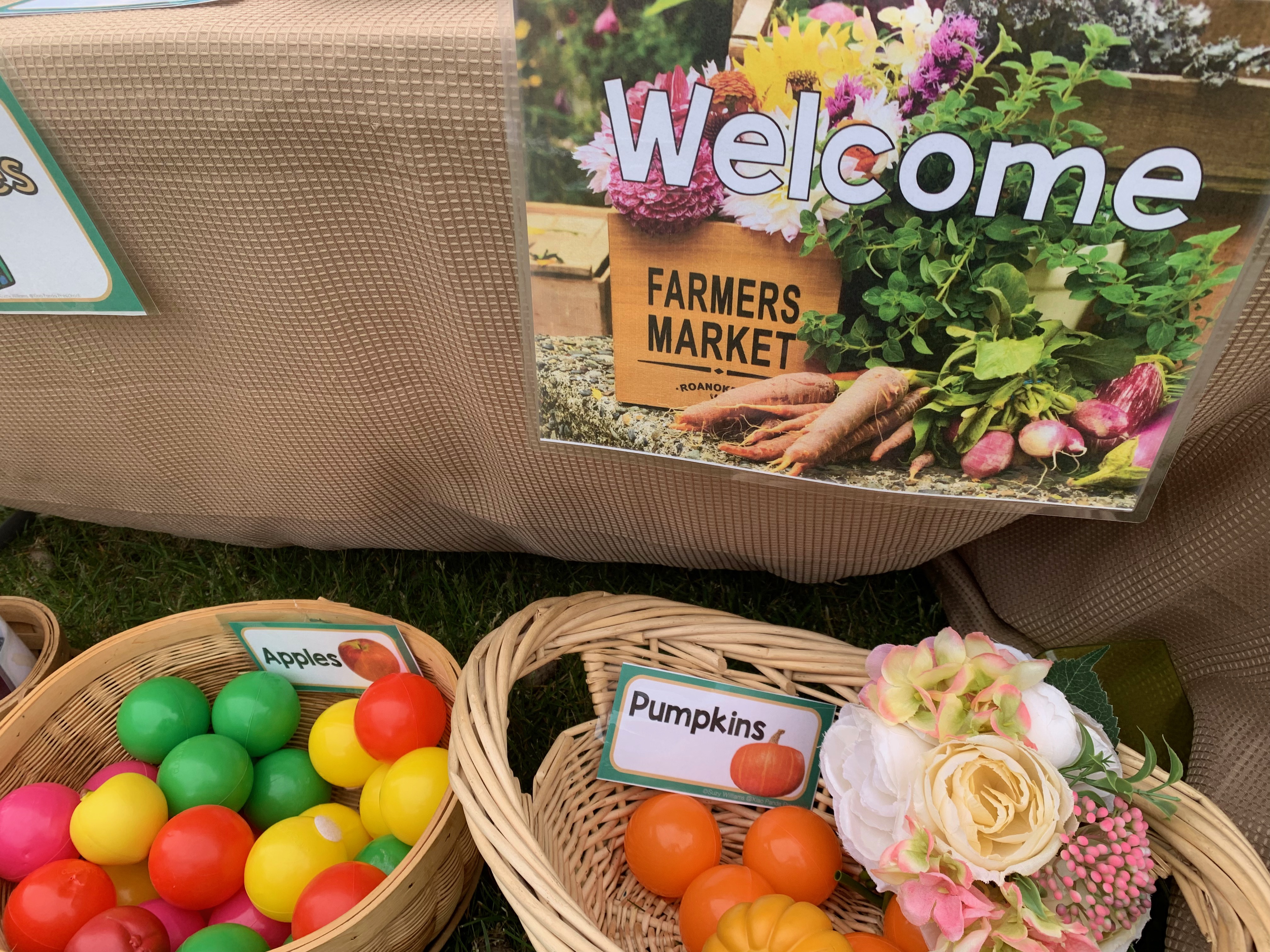
Setting Up the Farmers Market
If you’re looking to add an engaging and interactive activity to your preschool curriculum, a farmers market dramatic play center is an excellent option. Creating a farmers market in your classroom will not only provide an enjoyable activity for your students, but it can also teach them valuable life skills about farming, money, and food. Here are some tips for setting up a farmers market in your preschool:
Location – First, find a location for the farmers market dramatic play center in your classroom. Ideally, it should be in an area with enough space for students to move around comfortably and be easily accessible to them.
Display Tables – Next, gather some display tables or cardboard boxes to set up the farmers market. These will be used to display all the fruits and vegetables. You can add some baskets or crates to give it an authentic look. You can also decorate the area with posters, banners, and other props that highlight the theme of the farmers market.
Fruits and Vegetables – After you’ve set up the display tables, you’ll need to stock them with various fruits and vegetables. Consider using realistic-looking play food or even real fruits and vegetables if you’re up for it. If using real fruits and vegetables, make sure to change them out frequently to ensure freshness and avoid spoilage.
Money – Provide students with pretend money to use when “buying” fruits and vegetables at the market. You can use real coins and paper money or create your own. Assign prices to the different produce items so that children can practice their math skills while shopping.
Scales and Cash Registers – It can be fun to include scales for weighing produce and cash registers for students to “ring up” their purchases. This will add an extra layer of realism to the dramatic play center.
Overall, setting up a farmers market dramatic play center is an excellent way to promote creativity, imaginative play, and social skills in your preschool classroom. With the right setup, supplies, and props, your students can learn valuable skills while having fun.
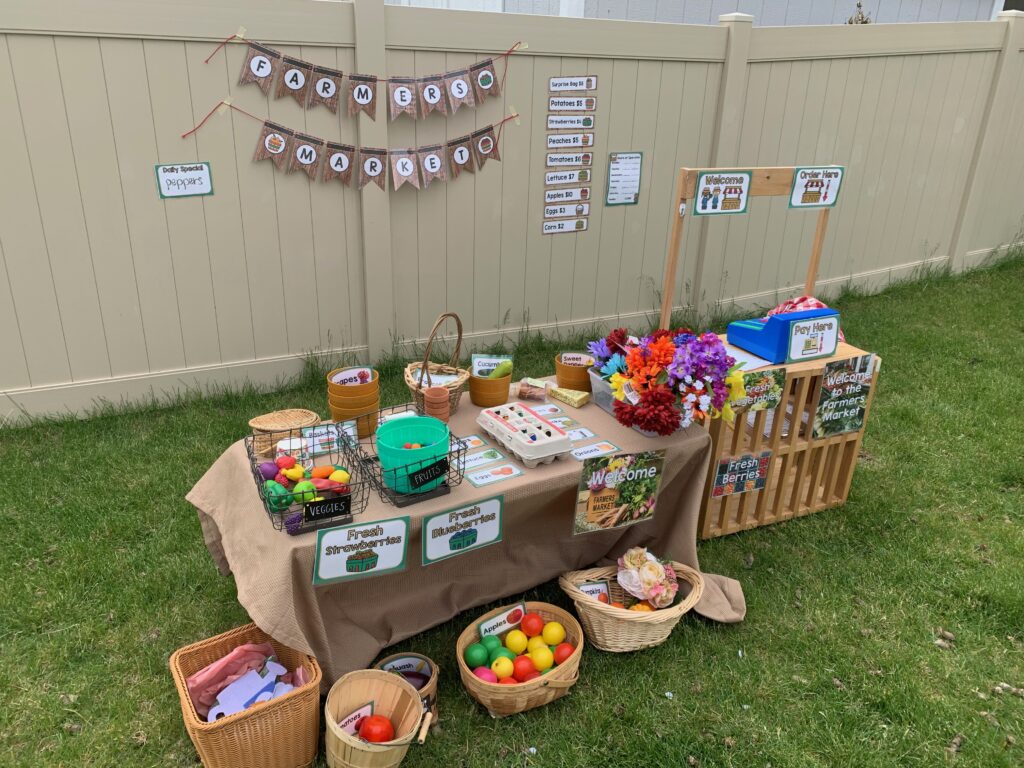
Supplies Needed for the Farmers Market
Setting up a farmers market dramatic play center in your preschool classroom requires a variety of supplies. To help you get started, here are some essential items you will need:
- Tables: (I use this one because it has adjustable height) To create an authentic farmers market, you will need at least one big or several small tables to set out all the supplies, baskets, and foods for play. You could also add a small table and chairs if you want to have a sitting or eating area. Make sure they are the right size for the children.
- Fruits and Vegetables: (I use these for everything – great quality!) A farmers market would not be complete without fresh fruits and vegetables. You can use fake plastic fruits and veggies or real ones for a more sensory experience. You can also use balls or open ended toys and the kids can turn them into any foods they’d like.
- Baskets and Containers: (I found tons at the local thrift store) The children will need baskets and containers to collect their produce. You can use real shopping baskets or create your own with cardboard or fabric.
- Cash Register and Play Money: (I use this cash register in any shop-related dramatic play set-ups). Provide a cash register and some pretend money, such as play coins or bills, so children can buy and sell their produce.
- Aprons and Hats: (I have extras laying around and the thrift store is a great place to find them) To make it more realistic, consider providing aprons and hats for the children to wear. This will also add an extra layer of fun to their role-playing.
- Price Tags and Signs: Create some price tags and signs to display the prices of the fruits and vegetables or use my set of labels, menus, shopping list, posters.
- Other Accessories: You can add other accessories, such as a tent, scale (I have this one), or pretend food containers, to make the farmers market more interactive and engaging for the children.
With these supplies, your preschool farmers market dramatic play center will come to life and offer endless opportunities for the children to learn and have fun.
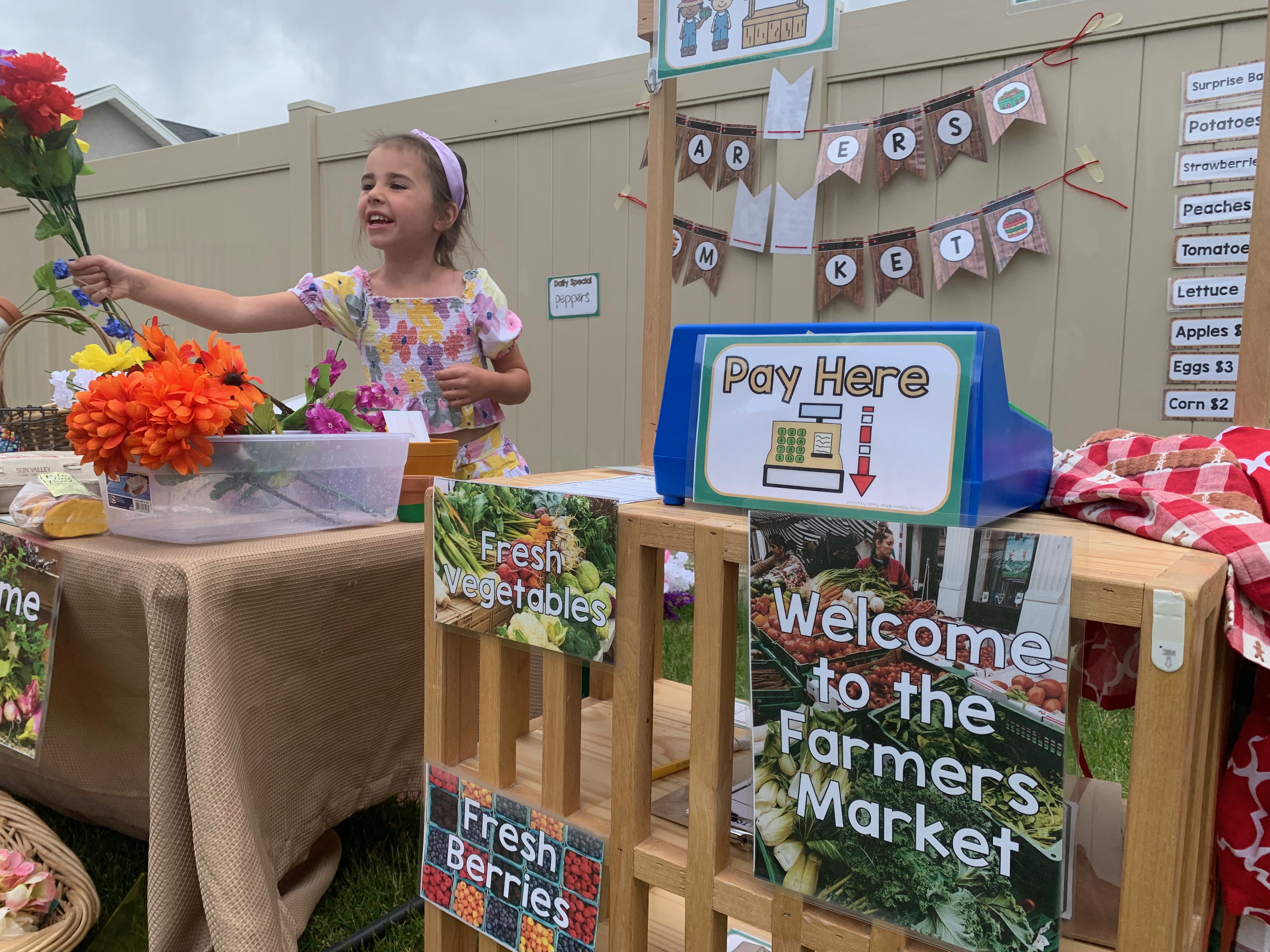
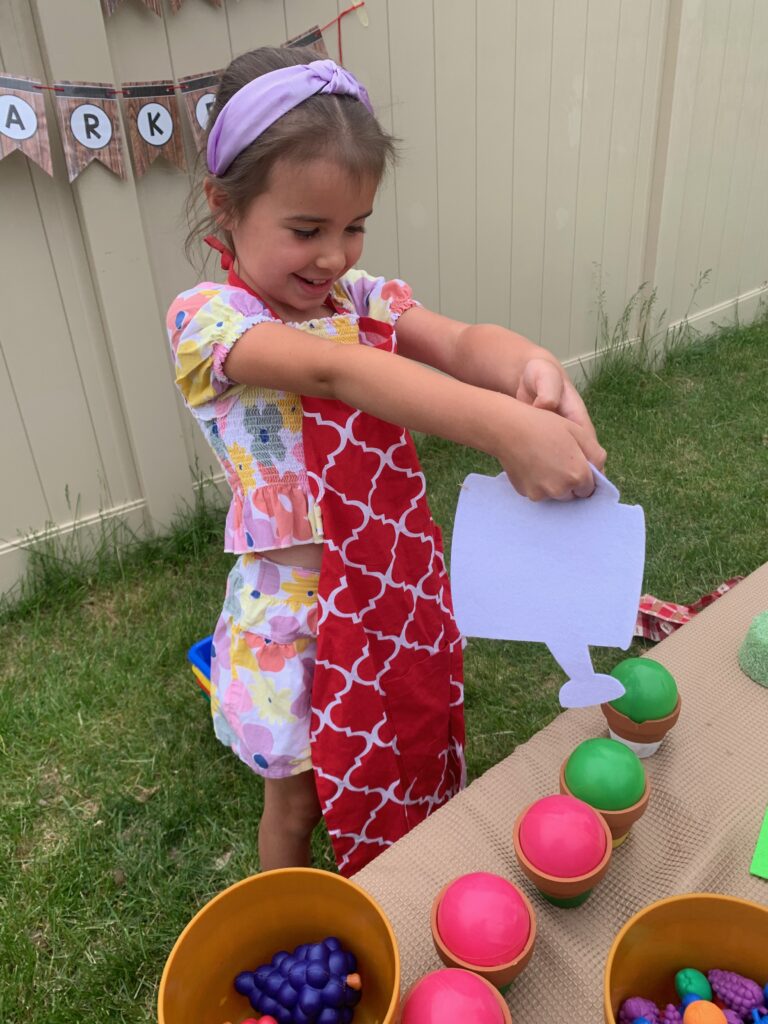
Role Play and Activities in the Farmers Market
Once you have set up your preschool farmers market dramatic play center, it’s time to start role-playing and engaging in fun activities with your students. Here are some ideas:
- Shop and Sell: Encourage your students to shop for fruits and vegetables in the market, using play money or tokens. They can then sell their purchases to other students or to the teacher.
- Food Sorting: Have your students sort fruits and vegetables into categories such as colors, shapes, or types. This will help them develop their math and language skills.
- Farm Animal Fun: Incorporate farm animal figures into the play area and have your students create their own scenarios and stories with them. You can also bring in books or videos about farm animals for extra learning opportunities.
- Cooking Station: Set up a play kitchen area near the market where your students can pretend to cook with the fruits and vegetables they have bought. Encourage them to talk about the recipes they are making and the nutritional benefits of the ingredients.
- Garden Planting: If you have a small garden or window box in your classroom, you can have your students plant and care for their own fruits and vegetables. This will give them a hands-on learning experience about the plant life cycle and where their food comes from.
Overall, the preschool farmers market dramatic play center is a fun and engaging way for your students to learn about healthy eating habits and the importance of farming and agriculture. With a little creativity and planning, you can create an immersive experience that your students will love.
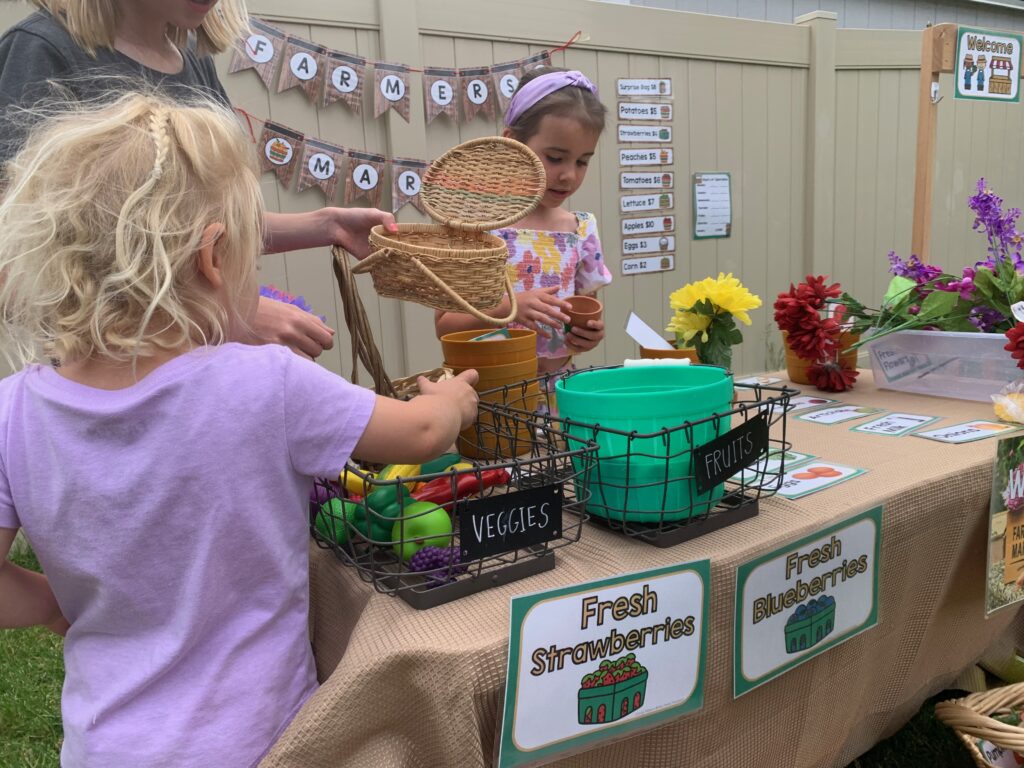
Safety Considerations for the Farmers Market
When creating a farmers market dramatic play center in your classroom, it’s important to consider safety precautions to ensure a safe and fun learning experience for your students.
Here are some safety considerations to keep in mind:
- Choose appropriate props and materials. Ensure that all materials and props used in the farmers market are safe for children to handle and play with. Avoid any sharp objects or choking hazards, and make sure all items are non-toxic and age-appropriate.
- Provide adult supervision. While dramatic play is an excellent way for children to learn and develop their social and emotional skills, it’s important to have adult supervision to ensure their safety. Assign an adult or teacher to oversee the play center and make sure children are following the rules and using materials properly.
- Encourage hand washing. To promote good hygiene, make sure you have a designated hand-washing area nearby the farmers market. Encourage children to wash their hands before and after playing with the materials.
- Teach fire safety. If your farmers market includes a pretend cooking area or a grill, be sure to teach your students about fire safety and how to handle materials that can become hot.
- Keep the play area organized. A well-organized play center makes it easier to keep track of the materials and props, which can reduce the risk of accidents or injuries. Make sure all items have a designated spot and are easily accessible to children.
By following these safety considerations, you can create a fun and safe farmers market dramatic play center in your classroom. Your students will love learning and playing in this interactive and engaging environment!
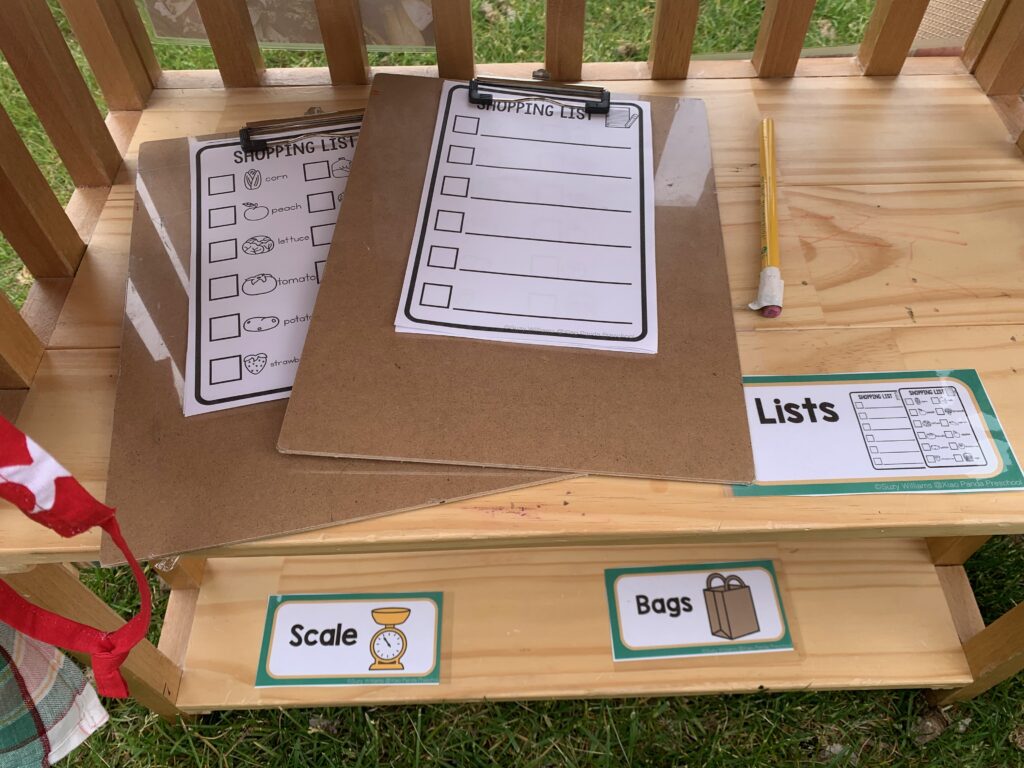
Cleaning and Maintaining the Farmers Market
As with any classroom activity center, it’s important to keep your farmers market clean and well-maintained. Here are some tips for cleaning and maintaining your farmers market dramatic play center:
- Establish Cleaning Procedures: Before introducing the farmers market to your students, establish a cleaning procedure that everyone is familiar with. This could involve wiping down surfaces, washing any fabric or plastic items, and sweeping the floor.
- Rotate Items: To keep the farmers market fresh and interesting, it’s a good idea to rotate the items available for play. Consider introducing new fruits and vegetables, swapping out baskets and containers, or even adding in new play money.
- Repair Damaged Items: With so many little hands playing in the farmers market, it’s likely that some items may become damaged or worn over time. Take the time to repair or replace any damaged items to ensure the play center is safe and enjoyable for everyone.
- Disinfect Regularly: Especially during cold and flu season, it’s important to regularly disinfect high-touch surfaces like the checkout counter, cash register, and shopping baskets.
- Involve Your Students: Teaching young students about the importance of keeping their environment clean and tidy is an important life skill. Involve them in the cleaning process by assigning tasks and making it part of your daily routine.
By keeping your farmers market dramatic play center clean and well-maintained, your students will enjoy hours of imaginative play and learning.
Conclusion
Incorporating a Farmers Market Dramatic Play Center in your classroom can offer many educational and developmental benefits for your students. From improving their communication and social skills to enhancing their imagination and creativity, this play area provides an opportunity for students to engage in meaningful and interactive play. By following the simple steps outlined in this post, you can set up an exciting and safe play center that your students will enjoy exploring. Remember to consider the age and developmental level of your students when choosing materials and activities for your farmers market, and encourage them to express their creativity and ideas. By maintaining and updating the farmers market, you can create a dynamic learning environment that will enrich your classroom experience. So why not bring the farm to your classroom and let the imaginative play begin?

